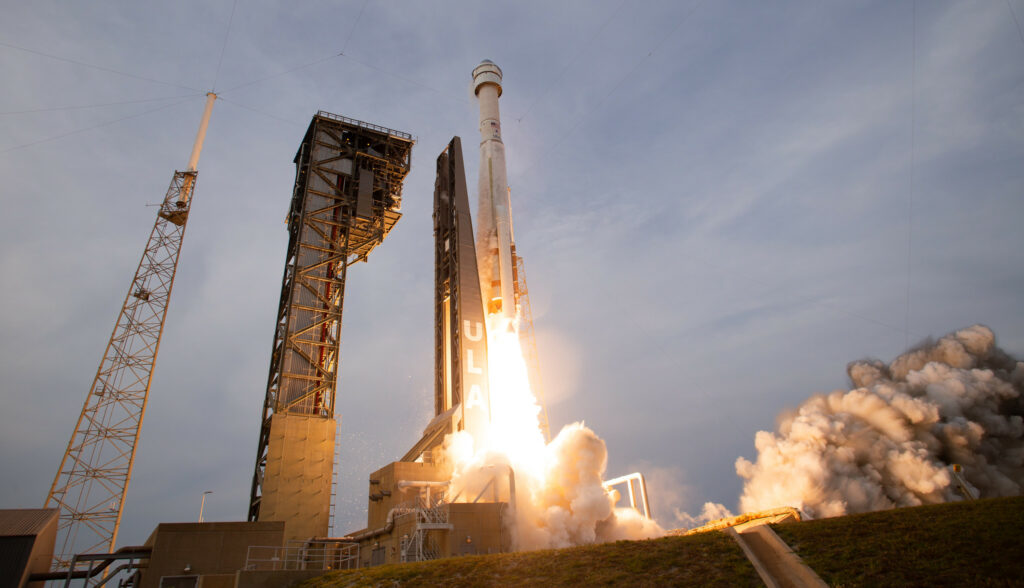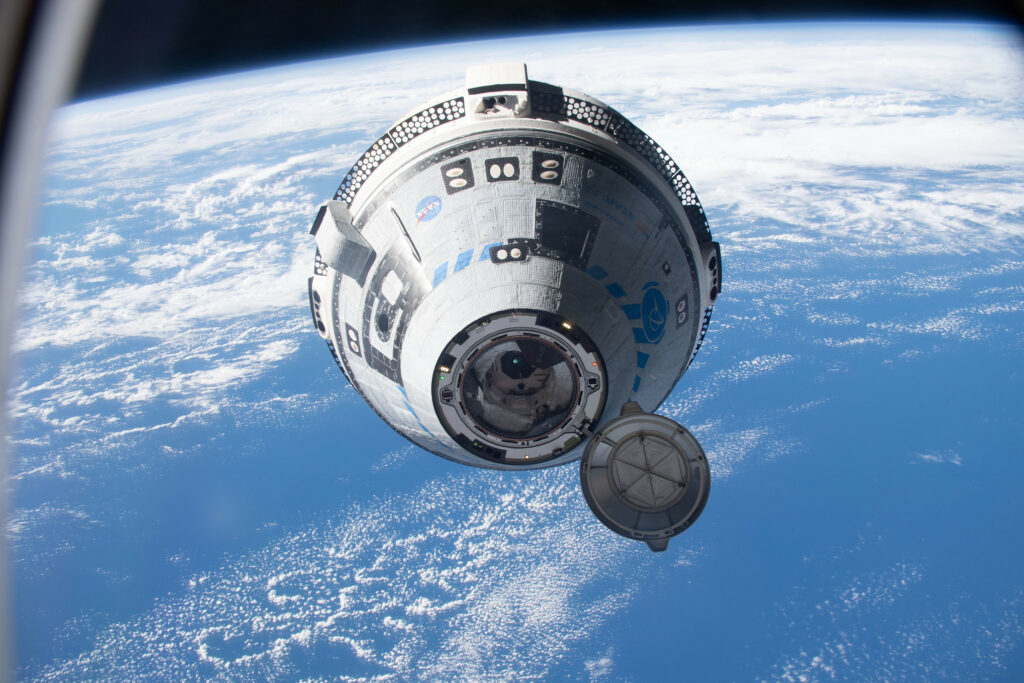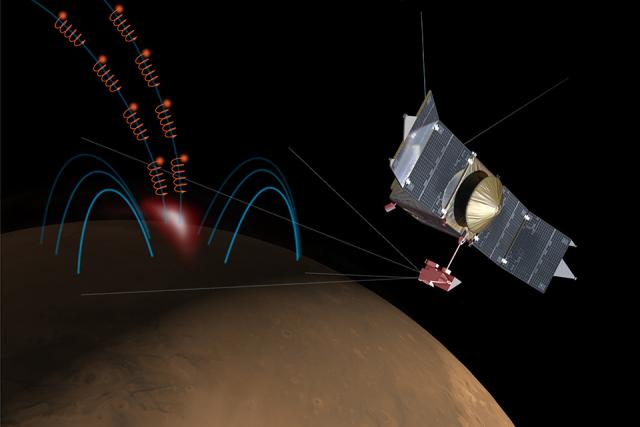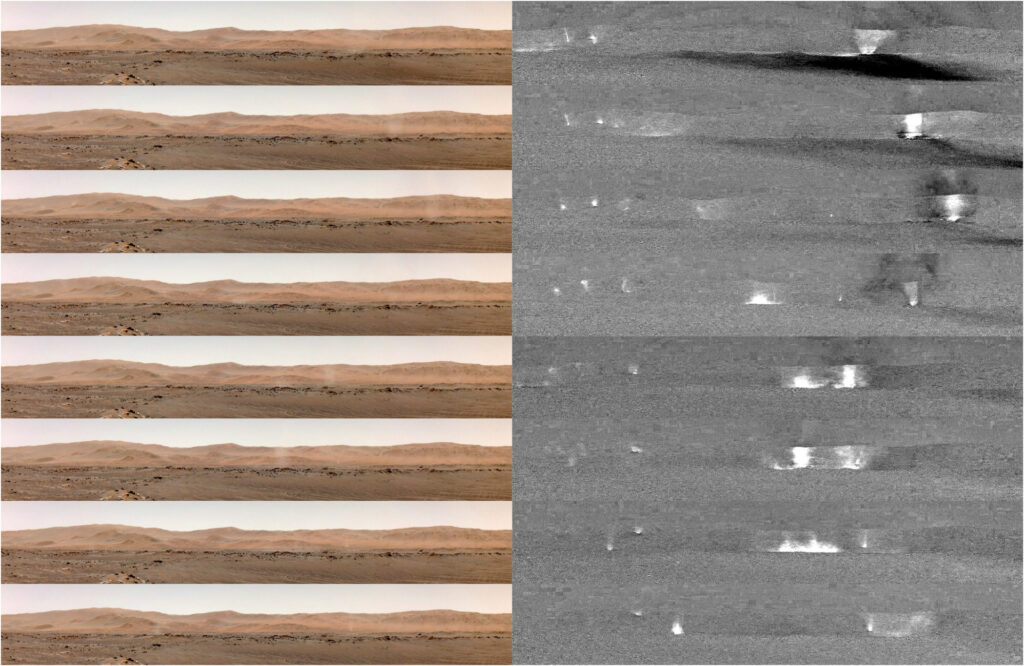Today, we take a look at three recent papers attempting to explain various phenomena on Mars. One uncovers the cause of discrete aurorae. Another explains the martian haze. And a third actually ends up with more questions than answers. Plus, Boeing’s OFT-2 returns to Earth, ESA’s Solar Orbiter makes its closest approach, and Dr. Pamela reviews the new graphic novel Galaxy: The Prettiest Star by Jadzia Axelrod.
Podcast
Show Notes
Boeing Starliner finally makes it to ISS
- Boeing press release
- Station Crew Opens Boeing Starliner Hatch, Enters Spacecraft (NASA)
- NASA press release
Satellites track the Earth’s eruptions
- Tracking Lava Lake Levels at an African Volcano from Space (Eos)
- “Intra-Crater Eruption Dynamics at Nyiragongo (D.R. Congo), 2002–2021,” Julien Barrière et al., 2022 April 1, JGR Solid Earth
ESA’s Solar Orbiter stuns with latest views of the Sun
- ESA press release
Aurorae on Mars understood with physics
- University of Iowa press release
- “Discrete Aurora at Mars: Dependence on Upstream Solar Wind Conditions,” Z. Girazian et al., 2022 March 27, JPR Space Physics
CO2 loss no longer reason Mars dried out
- University of Chicago press release
- “Changing spatial distribution of water flow charts major change in Mars’s greenhouse effect,” Edwin S. Kite et al., 2022 May 25, Science Advances
Dust devils help keep Mars hazy
- Dust devils and daytime upslope winds explain Mars’s constant haze (Phys.org)
- “The dynamic atmospheric and aeolian environment of Jezero crater, Mars,” Claire E. Newman et al., 2022 May 25, Science Advances
Transcript
Ah, hey Lindsey, where’s Pamela?
She was attacked by the monster that eventually gets all senior scientists.
Her software segmentation faulted?
No! No, that’s what happens to grad students. She had a telecon, so today you get me!
Since when did they start letting the Tiny Interns on air?
Look, you were still in middle school when I got that Twitter handle, I think. And I think I’ve earned my chance to tell all these good folks about volcanoes, the Solar Orbiter, and maybe even Mars.
Mars? I’m telling them about Mars.
We’ll split Mars.
Fine. But Starliner is all mine. And Pamela pre-recorded a review of Galaxy: The Prettiest Star.
All of this and more, right here on the Daily Space.
I am your host Erik Madaus.
And I am your host Lindsey Odom.
And we’re here to put science in your brain.

Something many of us weren’t convinced was actually going to happen finally happened – Boeing successfully sent their CST-100 Starliner to the International Space Station (ISS) and back as part of their Orbital Flight Test 2, or OFT-2, mission.
For those of you who don’t remember, OFT-1 was not the most successful mission, and OFT-2 had a few less than stellar early attempts at liftoff.
Back in December 2019, OFT-1 was a “high visibility close call” due to numerous issues with everything from the flight software to reaction control thrusters. It was unable to dock to the ISS.
After that spacecraft limped home, Boeing said they would do an OFT-2. It had the usual delays before finally rolling out to the pad. The first real launch attempt for that was in August 2021, but it was called off six hours before launch due to valve problems. Half of the valves that controlled the reaction control thrusters were corroded shut. The root cause: water intrusion. Someone didn’t take into consideration humidity with a spacecraft launched from Florida. The fix for this problem delayed the launch from August 2021 to May 2022.
And then there were the issues you just have to laugh at, like the protective window cover that yote off as they drove the capsule down the street.
Somehow, despite all these issues, OFT-2 managed to lift off on May 19, 2022.
While the craft did lift off, it was not without issues that had Pamela, who is not here so I can say this, totally shaking her head. For instance, the cooling loop got a bit too cold and iced up – turns out that if you don’t have four living, breathing things in the capsule producing heat, your cooling loop needs to be adjusted down.
Also, two of the three thrusters on one ‘doghouse’ of thrusters failed in the first hour of the flight, but the other thrusters in the three other ‘doghouses’ were able to compensate.

As the capsule got closer to the ISS and prepared to cross the imaginary boundary of the 200-meter ‘Keep Out Sphere’, it then had to pause for an extended period of time while engineers worked to troubleshoot an issue with the soft capture ring on the spacecraft’s NASA Docking System.
That ring is the three blades that extend out of the port and help roughly align and manage the loads when it contacts the station’s docking port. It also corrects for slight misalignments. The nature of the issue was not clear, but retracting and extending the soft capture ring fixed the issue and Starliner proceeded further in.
But then, Starliner had to pause again because lighting conditions weren’t sufficient to actually dock. For over an hour, the capsule held station just ninety meters away from the docking port — so close and so very, very far.
Eventually, Starliner was able to dock, and here we do have a moment of goodness and light. Boeing left the astronauts a neat surprise: the spacecraft’s zero-gravity indicator was a plush Jebediah Kerman, from the video game Kerbal Space Program. Jebediah got lots of positive feedback from space nerds across the social internet – something Boeing sorely needed with all of the issues and delays encountered by this spacecraft.
I have to admit that I’ve got some real mixed feels about Jebediah being the zero-g indicator. At a certain level, my experience with KSP isn’t all that different from Boeing’s with Starliner. Sometimes, you succeed in spite of serious design and operational issues, and you learn from your mistakes.
I hope Boeing learned.

Mostly, I’m just unsurprised to see a defense contractor pander to space nerds.
Still, I admit that I found where to get one of the plushies and bought one myself. I am not immune to consumerism, particularly when cute things are involved. Just ask TinyIntern, who sends me links to opossum stuff all the time.
Also, Tiny, get ready; you’re next.
Back on topic. Starliner stayed at the ISS for several days, demonstrating that it can stay powered down attached to the station like it will need to do for a six-month operational mission.
Starliner successfully returned to Earth the evening of Wednesday, May 25, carrying some cargo back to White Sands Missile Range in New Mexico. Like the first mission, reentry and the parachute deployments were nominal. Among the cargo on return were some empty gas canisters used for the station’s atmosphere.
Like the Soyuz, Starliner returns to a landing on solid ground, but instead of the small rockets used on the Soyuz and New Shepard, Starliner uses airbags for the final touchdown.
Assuming the Data Review goes well, and all indications are that it will, Starliner will fly its Crew Flight Test later this year, with its first operational mission in 2023. There are finally two U.S. spacecraft capable of sending crew to and from the ISS, the goal of the Commercial Crew Program started over a decade ago.
And if things don’t go well for the Data Review, there is another spacecraft getting ready to fly: the Dream Chaser. Expect to hear more on that little space plane as 2023 approaches.

A few episodes back, we brought you the story of how a NASA satellite spotted an erupting sharkcano: an underwater volcano in the Solomon Islands that is (was) filled with sharks.
Today, we have news of another volcano behaving badly. This time it is the Nyiragongo volcano in the Democratic Republic of Congo. No one has eyes on all the seas or the right perspective into the lava-spewing mountains that pox our planet. However, new research published in the Journal of Geophysical Research: Solid Earth uses synthetic aperture radar data from satellites to measure the level of the lava lake at the peak of the mountain.
All of this data collected can now be used to predict volcanic hazards to the region. So while the total population of satellites may seem to be becoming overwhelming, science can use every mission we can get, and even as an amateur astronomer, I’m still grateful for the telescopes that point down.
Heck, it turns out that I even get giddy about telescopes pointed at the Sun!
On March 26, ESA’s Solar Orbiter made its closest approach to the Sun and reached an external temperature of about 500 degrees Celsius or 900 degrees Fahrenheit. This spacecraft has the ultimate in heat-shielding technology that allows the mission to survive to do science; science that includes flying over the Sun’s north and south poles. Solar Orbiter has also captured our highest-resolution image of the Sun’s South Pole.
These images are super exciting, but the roughly eight weeks since the encounter hasn’t been enough time for researchers to learn what solar science is revealed in this new data. For that, we’re just going to have to wait.
In the meantime, we can talk about some scientific results coming out of various Mars missions.

As a photographer, one of the targets on my bucket list is the Northern Lights. As the Sun ramps up into a solar maximum, the chance of the aurorae reaching where I live is increasing, so that’s good. More solar activity means more aurorae, which are, all told, pretty common here on Earth. But today I learned that there are also aurorae on Mars.
Which doesn’t make sense to me as Mars doesn’t have a global magnetic field as Earth does. Still, NASA’s MAVEN spacecraft has observed over 200 so-called ‘discrete’ aurorae which only occur in the southern hemisphere of the red planet. And physicists have analyzed those observations and discovered that the solar wind – which causes aurorae on Earth – is interacting with localized bits of crustal magnetic fields to create those discrete aurorae.
Co-author Zachary Girazian explains: Our main finding is that inside the strong crustal field region, the aurora occurrence rate depends mostly on the orientation of the solar wind magnetic field, while outside the strong crustal field region, the occurrence rate depends mostly on the solar wind dynamic pressure.
So while Mars doesn’t have a global magnetic field, there are enough magnetic field generating regions in the southern hemisphere to interact with the solar wind. And now you know.
Oh, wow. I would love to get a photo of an aurora on Mars.

While one team of scientists has solved a martian mystery, another team has kind of created another one. Here’s what we know. Once upon a time, a long, long time ago, Mars had water. Enough water that even today, we can see the effects of flowing rivers and streams on the landscape. Perseverance’s landing place, Jezero crater, was even once a lake.
Then at some point in Mars’ history, all that water went away. And since our first orbital images of Mars were captured even before Dr. Pamela was born, scientists have been trying to understand just why Mars lost its water and became the desert planet it is now.
In a new paper published in Science Advances, a team led by geophysical scientist Edwin Kite analyzed the tracks of those rivers, creating a timeline of the changes in elevation and even latitude of flowing water. They used all that data to run simulations, and they found… well, they found that changing the amount of carbon dioxide did exactly nothing.
Carbon dioxide is a greenhouse gas, which means the presence of CO2 in the atmosphere helps warm a planet. Losing that CO2 is a great explanation for why Mars’ water was able to dissipate out to space or froze and ended up underground. Except carbon dioxide loss is clearly not the reason Mars dried out.
Scientists working on this project are now planning to use both the Curiosity and Percy rovers to study their respective landing zones for evidence to support a different explanation. And we’ll, of course, update you when they learn more.
Just when you think you understand a planet…

Oh, wait. Another paper in Science Advances explains a different martian phenomenon – the constant atmospheric haze. An international team of researchers studied data from 216 sols’ worth (those are martian days) of Perseverance observations on air pressure, temperature, and wind speed. And the result is that dust stays aloft on Mars because of dust devils.
First, it’s aurorae and now, it’s dust devils. Mars is awesome.
It turns out that dust devils actually occur pretty frequently on the red planet, with at least one popping up near Percy every day. And those swirling bits of dust are one of the reasons the air is hazy – they help replenish dust that may have settled. Plus there are also upslope winds that, while less common, pull more dust into the atmosphere. Between the two processes, Mars gets to stay hazy much of the time.
As the red planet heads into its winter season, the frequency of larger dust storms will increase, making sure that the atmosphere remains hazy. That’s why we’re losing InSight and probably Ingenuity this year – all that dust also blocks out the sunlight that charges their batteries via solar panels.
So two out of three Mars stories answered their questions. Not a bad record.
And now, we’re going to present Dr. Pamela’s pre-recorded review of Galaxy: The Prettiest Star.
Review

Around the Daily Space team, we are willing to do a review of anything that can be somehow vaguely kind of sorta related to astronomy. From Starlight Coke to shoes covered in space patterns, we’ve strayed far and wide. Today’s pick, well, we picked it because of the title and really didn’t expect to find any clear science, and I am here to say, this story has better science than its title led me to expect.
Today, I review one of DC Comics‘ latest graphic novels — Galaxy: The Prettiest Star. Written by Jadzia Axelrod, with illustrations by Jess Taylor and lettering by Ariana Maher, this story is set in a world where Superman keeps Metropolis safe, but the small towns beyond the city are still places where anything other than a Beaver Cleaver or Brady Bunch reality is something other than acceptable. It is in this kind of rural nothing of a place that a boy named Taylor lives an invisible life with a picture book family.
The thing about picture books is that they only show people what they want to see. The true moments of life are often left out, and maybe not even photographed. The picture Taylor and his family paint? It’s not real.
Taylor, as we can guess from the cover of this vibrantly colored work of art, is actually a beautiful alien – a stunning girl forced to hide herself in another body to hide from the things that might hurt her. Released under DC Comics’ pride logo, this story is an allegory for the life of someone growing up trans and trying to find the courage to let the world see them for who they are. Again, this is a detail you can get from the cover – in this case, from a cover quote from Nicole Maines.
I went into this story thinking I had an idea of the plot and a notion of the ending, and I was really expecting a surprise-free ride along a known path. And to a degree, that’s what I got: a story of candy-colored joy mixed with the angst of being a teenager and the struggle of figuring out how to grow up and be true to yourself.
But it is in the details that this story shines. When Taylor becomes her alien self, she loves pickle juice, and that’s the kind of detail that if you know, you know. And it’s awesome.
And there is science.
The story is set in a town with a radio observatory, and the point is made that there are no cell phone towers, and wifi just isn’t a thing, and that is all correct. There are poetic allusions to physics and art and how, with the right senses, our science could be heard like an orchestra that shapes our reality.
And there are descriptions of galaxies that are heartbreaking in their beauty. I want to read you a brief section that is going to be my new way to see our universe. Axelrod writes: Galaxies are essentially Island universes: isolated pockets of brightness and activity in the Darkness. Stars, gases, dust, and dark matter swirling around together, held close by invisible bonds. All spinning around an unsteady center. A galaxy is not one thing. It can’t be. It’s made up of too many disjointed parts.
There is science in this book, the first of what I hope will become a new series, and that science is true, and it is beautiful, but more importantly, the characters – in all their flaws and in all their strength – they, too, are true. This story is a beautiful introduction to what could be DC’s newest superhero — Galaxy, who was called the prettiest star. And haven’t we all, once or twice, mistaken a quasar for a beautiful star?
This graphic novel is available wherever comic books are solid, assuming they aren’t sold out yet. We encourage you to get or order your copy at your local comic book store, and failing that, we have links to order it online, all on our website, DailySpace.org.
This has been the Daily Space.
You can find more information on all our stories, including images, at DailySpace.org. As always, we’re here thanks to the donations of people like you. If you like our content, please consider joining our Patreon at Patreon.com/CosmoQuestX.
Credits
Written by Pamela Gay, Beth Johnson, Erik Madaus, and Gordon Dewis
Hosted by Erik Madaus and Lindsey Odom
Audio and Video Editing by Ally Pelphrey
Content Editing by Beth Johnson
Intro and Outro music by Kevin MacLeod, https://incompetech.com/music/


 We record most shows live, on Twitch. Follow us today to get alerts when we go live.
We record most shows live, on Twitch. Follow us today to get alerts when we go live.